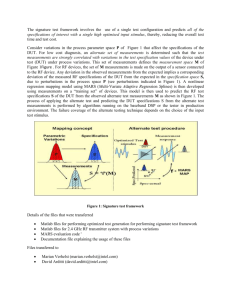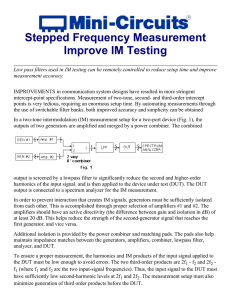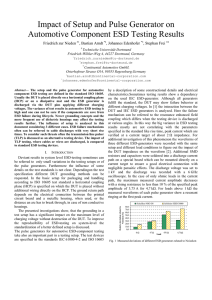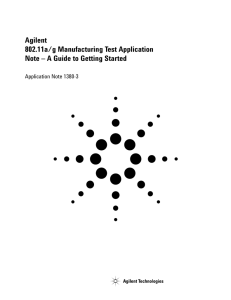application note #1 fresnel insertion loss measurement
advertisement
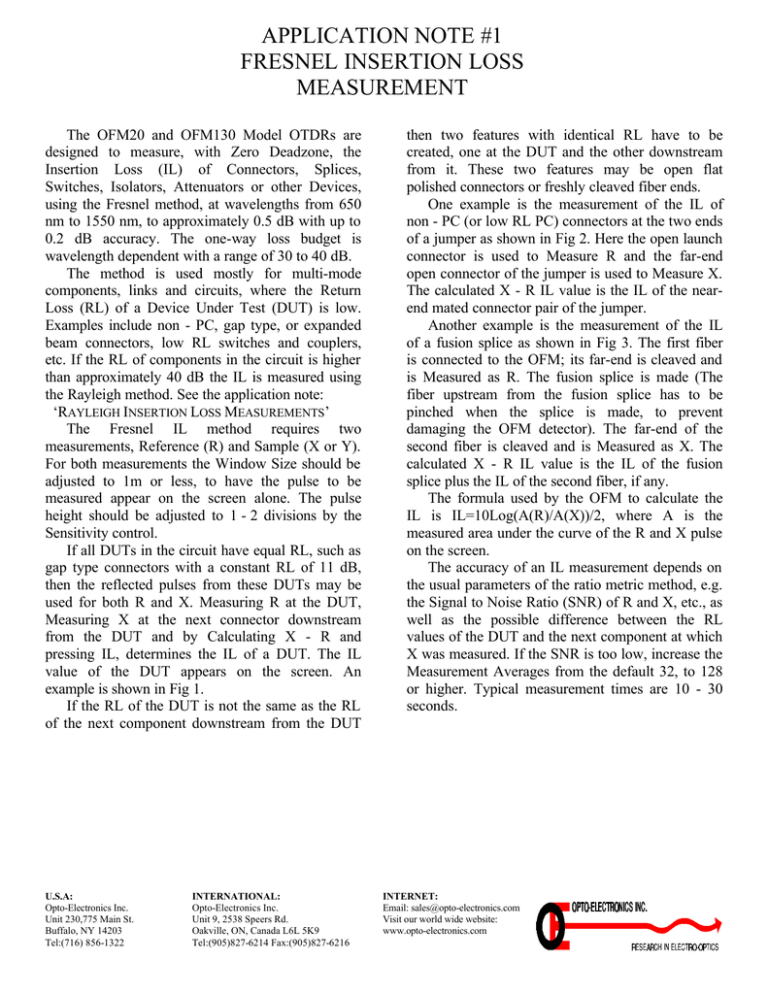
APPLICATION NOTE #1 FRESNEL INSERTION LOSS MEASUREMENT The OFM20 and OFM130 Model OTDRs are designed to measure, with Zero Deadzone, the Insertion Loss (IL) of Connectors, Splices, Switches, Isolators, Attenuators or other Devices, using the Fresnel method, at wavelengths from 650 nm to 1550 nm, to approximately 0.5 dB with up to 0.2 dB accuracy. The one-way loss budget is wavelength dependent with a range of 30 to 40 dB. The method is used mostly for multi-mode components, links and circuits, where the Return Loss (RL) of a Device Under Test (DUT) is low. Examples include non - PC, gap type, or expanded beam connectors, low RL switches and couplers, etc. If the RL of components in the circuit is higher than approximately 40 dB the IL is measured using the Rayleigh method. See the application note: ‘RAYLEIGH INSERTION LOSS MEASUREMENTS’ The Fresnel IL method requires two measurements, Reference (R) and Sample (X or Y). For both measurements the Window Size should be adjusted to 1m or less, to have the pulse to be measured appear on the screen alone. The pulse height should be adjusted to 1 - 2 divisions by the Sensitivity control. If all DUTs in the circuit have equal RL, such as gap type connectors with a constant RL of 11 dB, then the reflected pulses from these DUTs may be used for both R and X. Measuring R at the DUT, Measuring X at the next connector downstream from the DUT and by Calculating X - R and pressing IL, determines the IL of a DUT. The IL value of the DUT appears on the screen. An example is shown in Fig 1. If the RL of the DUT is not the same as the RL of the next component downstream from the DUT U.S.A: Opto-Electronics Inc. Unit 230,775 Main St. Buffalo, NY 14203 Tel:(716) 856-1322 INTERNATIONAL: Opto-Electronics Inc. Unit 9, 2538 Speers Rd. Oakville, ON, Canada L6L 5K9 Tel:(905)827-6214 Fax:(905)827-6216 then two features with identical RL have to be created, one at the DUT and the other downstream from it. These two features may be open flat polished connectors or freshly cleaved fiber ends. One example is the measurement of the IL of non - PC (or low RL PC) connectors at the two ends of a jumper as shown in Fig 2. Here the open launch connector is used to Measure R and the far-end open connector of the jumper is used to Measure X. The calculated X - R IL value is the IL of the nearend mated connector pair of the jumper. Another example is the measurement of the IL of a fusion splice as shown in Fig 3. The first fiber is connected to the OFM; its far-end is cleaved and is Measured as R. The fusion splice is made (The fiber upstream from the fusion splice has to be pinched when the splice is made, to prevent damaging the OFM detector). The far-end of the second fiber is cleaved and is Measured as X. The calculated X - R IL value is the IL of the fusion splice plus the IL of the second fiber, if any. The formula used by the OFM to calculate the IL is IL=10Log(A(R)/A(X))/2, where A is the measured area under the curve of the R and X pulse on the screen. The accuracy of an IL measurement depends on the usual parameters of the ratio metric method, e.g. the Signal to Noise Ratio (SNR) of R and X, etc., as well as the possible difference between the RL values of the DUT and the next component at which X was measured. If the SNR is too low, increase the Measurement Averages from the default 32, to 128 or higher. Typical measurement times are 10 - 30 seconds. INTERNET: Email: sales@opto-electronics.com Visit our world wide website: www.opto-electronics.com
